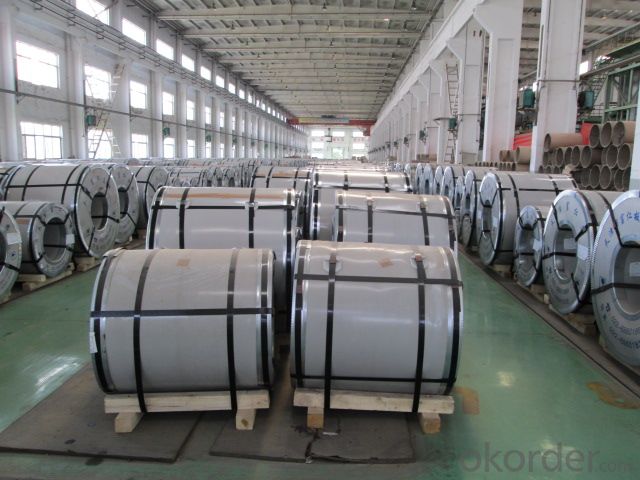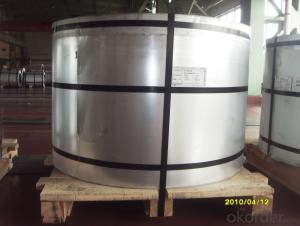Electrolytic Tinplate Sheets for 0.27mm Thickness MR Sheets
- Loading Port:
- Tianjin
- Payment Terms:
- TT or LC
- Min Order Qty:
- 25 m.t.
- Supply Capability:
- 8000 m.t./month
OKorder Service Pledge
OKorder Financial Service
You Might Also Like
1.Structure of Electrolytic Tinplate Sheets for 0.27 Thickness MR Sheets Description
Electrolytic Tinplate Sheets is one of the metal packing materials, which is widely used for making painting cans ,chemical package cans , electrical cable ,battery and metal printing etc.
2. Main Features of Electrolytic Tinplate Sheets for 0.27 Thickness MR Sheets
Steady and high quality
Fast shipment
Good experience for export work
For the surface, Plate uniform in thickness,uniform and smooth tin coating, without flaws,rusts,scratch,wave,nick of tin coating etc.
Price competitive
3.Electrolytic Tinplate Sheets for 0.27 Thickness MR Sheets Images

4. Electrolytic Tinplate Sheets for 0.27 Thickness MR Sheets Specification
Standard : GB2520-2000 ,JIS G3303
Steel type : SPCC,MR
Coating : 2.8/2.8
Surface: Bright, Stone ,
Thickness:0.31
Width :600MM~1000MM
Temper : T1~T5
Package: tinplate wrapped completely with an inner cover of plastic or waterproof papers with vorners protected with metal angels.
5.FAQ of Electrolytic Tinplate Sheets for 0.27 Thickness MR Sheets
A. What is the package of tinplate? (Referred as below)
For sheets, thin plastic film + rust-proof paper + metallic cover + metallic angles+ steel band strips + fumigated wooden pallet.
For coil, thin plastic film + rust proof paper + metallic cover + steel band strips + fumigated wooden pallet
B. The surface of tinplate could you supply?
Stone finish, Bright finish, Matte finish, Silver finish
C. What quantity is the minimum order of tinplate?
Usually, the minimum quantity is 25MT. For special case, consult with us.
D. Can it make to be BA or CA for annealing?
Yes, both can do with.
- Q:How does tinplate contribute to the overall protection of packaged products?
- Tinplate contributes to the overall protection of packaged products by providing a durable and corrosion-resistant material that helps to prevent contamination, spoilage, and damage during storage and transportation. Its robustness acts as a barrier against external factors such as moisture, oxygen, light, and microorganisms, safeguarding the quality and integrity of the packaged items. Additionally, tinplate's ability to maintain a consistent temperature helps to preserve the freshness and taste of perishable goods, making it an ideal choice for protecting packaged products.
- Q:How does tinplate compare to other packaging materials?
- Tinplate offers several advantages compared to other packaging materials. It is highly durable, providing excellent protection for the packaged goods. Tinplate is also resistant to corrosion, ensuring the longevity of the packaging. It is lightweight, making it cost-effective for transportation and storage. Additionally, tinplate is versatile, allowing for various shapes and sizes of packaging, and it provides an attractive appearance, enhancing the visual appeal of the product. Overall, tinplate is a reliable and efficient packaging material that offers numerous benefits in comparison to other alternatives.
- Q:How does tinplate perform in high humidity environments?
- Tinplate performs well in high humidity environments due to its corrosion resistance properties. The tin coating on the steel substrate acts as a barrier, preventing moisture from reaching the metal surface and causing corrosion. Therefore, tinplate is an excellent choice for packaging and other applications in high humidity conditions.
- Q:What are the different methods of printing on tinplate?
- There are several methods of printing on tinplate, including lithography, screen printing, and digital printing. Lithography involves transferring an image onto a metal plate, which is then used to print onto the tinplate. Screen printing uses a mesh screen to apply ink onto the tinplate through open areas of the screen. Digital printing utilizes computer-controlled printers to directly apply ink onto the tinplate, allowing for greater flexibility and detailed designs.
- Q:What are some common tinplate products?
- Some common tinplate products include food cans, beverage cans, aerosol cans, metal closures, and tinplate packaging for various consumer goods.
- Q:How is tinplate recycled and what are the benefits of recycling?
- Tinplate is primarily recycled through a process called steel recycling, where the tin coating is removed and the steel is melted down to produce new products. The benefits of recycling tinplate are numerous. Firstly, it conserves natural resources as it reduces the need for virgin steel production. Additionally, recycling tinplate reduces energy consumption and greenhouse gas emissions associated with the manufacturing process. It also helps in reducing landfill waste and supports a circular economy by promoting the reuse of materials. Overall, tinplate recycling contributes to environmental sustainability and resource efficiency.
- Q:Can tinplate be used for high-temperature applications?
- No, tinplate is not suitable for high-temperature applications as it has a low melting point and may lose its structural integrity at elevated temperatures.
- Q:What printing methods are used on tinplate?
- Some of the printing methods commonly used on tinplate include lithography, screen printing, and offset printing.
- Q:How does tinplate perform in terms of aroma and flavor preservation?
- Tinplate performs exceptionally well in terms of aroma and flavor preservation. Its non-reactive properties ensure that the taste and smell of the food or beverage packed in tinplate containers remain intact, without any transfer of unwanted flavors or odors. Additionally, the tight seal provided by tinplate packaging prevents the entry of external elements that could affect the product's taste or smell, thus preserving the original aroma and flavor for an extended period of time.
- Q:What are the disadvantages of using tinplate?
- Some disadvantages of using tinplate include its susceptibility to rust and corrosion, limited design options due to its rigid nature, higher cost compared to alternative materials, and potential health risks if the tin coating is damaged and ingested.
1. Manufacturer Overview |
|
|---|---|
| Location | |
| Year Established | |
| Annual Output Value | |
| Main Markets | |
| Company Certifications | |
2. Manufacturer Certificates |
|
|---|---|
| a) Certification Name | |
| Range | |
| Reference | |
| Validity Period | |
3. Manufacturer Capability |
|
|---|---|
| a)Trade Capacity | |
| Nearest Port | |
| Export Percentage | |
| No.of Employees in Trade Department | |
| Language Spoken: | |
| b)Factory Information | |
| Factory Size: | |
| No. of Production Lines | |
| Contract Manufacturing | |
| Product Price Range | |
Send your message to us
Electrolytic Tinplate Sheets for 0.27mm Thickness MR Sheets
- Loading Port:
- Tianjin
- Payment Terms:
- TT or LC
- Min Order Qty:
- 25 m.t.
- Supply Capability:
- 8000 m.t./month
OKorder Service Pledge
OKorder Financial Service
Similar products
New products
Hot products
Hot Searches
Related keywords



























